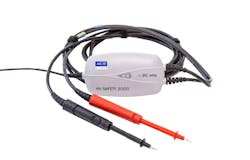Ensure safety and efficiency in EV repair
Oct. 5, 2023
3 min read
With the rapid evolution of electric vehicles (EVs), the landscape of vehicle repair has undergone a significant transformation. Basic tools and safety measures have taken on a new dimension, requiring both vehicle owners and repair shops to adapt to this emerging reality. As the automotive industry embraces electrification, it's imperative that safety protocols keep pace. Let's delve into the critical safety practices that every repair professional should be well-versed in, ensuring a secure and efficient repair process.
Why training is crucial for EV repairs
In the world of EV repair, having the right safety equipment is non-negotiable. Shops are expected to be equipped with standard EV gloves, specialized clothing, appropriate footwear, rubber mats, a shepherd's hook, and a device for verifying the vehicle's safety for repair. However, owning these tools is just the first step in guaranteeing safety. A crucial aspect that often gets overlooked is the proper training for their correct usage.
Navigating the intricate world of EV repair involves more than just having the necessary tools at your disposal. It requires a comprehensive understanding of the unique demands of each EV model and its battery. The battery table – a pivotal aspect of EV repair – is often overlooked in training sessions. Different original equipment manufacturers (OEMs) demand specific battery tables, as the weight of EV batteries varies widely. Many repair shops have discovered this the hard way, realizing that their standard battery tables fall short of meeting the weight requirements of some vehicles. For instance, a Tesla repair table may be inadequate for repairing a Rivian, and as larger vehicles from domestic OEMs enter the market, the need for even larger tables becomes evident.
The strength capacity of repair tables is a significant concern for shop owners, warranting detailed attention. However, for the purpose of this discussion, let's return to the fundamental principles of proper usage of personal safety gear. High-voltage gloves, a staple in EV repair, need regular inspection to ensure their effectiveness. While gloves are essential, it's equally crucial to recognize the role of footwear. A simple hole in a shoe can compromise safety, underlining the necessity of wearing the right footwear along with the appropriate rubber mat.
To further streamline the EV repair process and enhance safety, new technology has stepped in to provide innovative solutions. Companies like AVL offer devices that guide repair professionals through essential steps to verify that a vehicle is properly discharged and safe to undergo repairs. These steps encompass a meticulous process, starting with the vehicle's power-down procedure. They ensure that residual electrical energy is effectively dissipated, minimizing the risks associated with high-voltage systems.
Create a safe working environment
In essence, the process involves securing the vehicle, initiating the shutdown sequence, and using designated tools to verify the absence of voltage. The goal is to create a completely safe working environment for repair professionals. As the EV market continues to evolve, the collaboration between technological advancements and skilled technicians becomes paramount.
The transition to EVs has introduced new challenges and opportunities in the realm of vehicle repair. Alongside the advent of innovative tools, it's essential for repair professionals and shop owners to emphasize proper training in using safety equipment. Having the right tools is the foundation, but knowledge is the cornerstone of a safe and efficient EV repair process. As EV technology continues to advance, embracing these safety measures and incorporating technological solutions will be key to ensuring the well-being of repair professionals and the successful repair of electric vehicles.
About the Author

Dave Gruskos
David Gruskos, the president of Reliable Automotive Equipment, has been working in the automotive and collision repair industry for over 40 years. Currently a director for the Society of Collision Repair Specialists, Dave is also a well-known speaker and educator who presents regularly at major trade shows around the country. Dave works closely on many OE certification programs including manufacturers such as Audi, Mercedes-Benz, and Porsche, among others. Dave is also very active in the design and development of tooling requirements for many OEMs.
Sign up for our eNewsletters
Get the latest news and updates
